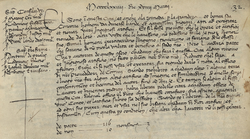Patent
A patent gives an inventor the right to stop other people making or using their invention. If someone makes or uses that invention without being allowed to, the inventor can sue that person in court to make them stop. The inventor can sell the patent to another person or company.
A patent lasts for up to 20 years, depending on the country. After that, anyone can copy the invention.
Each country has its own patents. China gives Chinese patents. India gives Indian patents. The United States gives United States patents. An inventor can get a patent in any country the inventor wants. An inventor can get patents in many different countries for the same invention. Each patent in each country costs money to get.
The rules for patents are similar in most countries.
Getting a patent
To get a patent, the inventor must ask the government by describing the invention in writing. This is called a patent application. The inventor can write the patent application, but it is usually written by a person trained to write patent applications. This person is called a patent agent or, if the person is a lawyer, a patent attorney.
The government does not usually just give the inventor a patent. Instead, the government tries to confirm whether the idea is actually new. This is called patent examination. The government will try to find books, stories, or other patents that show that the idea was not new. The inventor, or his or her patent attorney, then tries to show how the inventor's idea is actually new and is different from anything that the government finds.
If the government finds that the inventor's idea is new, it will give the inventor a patent. The government will also send the inventor a copy of his or her patent application with a special seal. This copy is the patent.
The inventor must also pay the government a tax to get a patent. Usually, an inventor pays money to ask for the patent, and the inventor pays money when they get a patent. In some countries, the owner of a patent must also pay money to keep the patent. Some can be cheap and some can be expensive.
Using a patent
The owner of a patent can stop other people from using their invention. If someone other than the patent owner uses the patent, this is called infringing a patent. If the owner knows that someone is infringing his or her patent, the patent owner can ask a court to stop them. If the court agrees that the other person was using the patent, the court can make that person pay a fine to the patent owner.
The patent owner can give other people permission to use their patent. This is called a patent license. A person who wants to use another person's patent will usually pay money to the patent owner.
What can be patented
Patents most often cover products or processes that contain 'new' functional or technical ideas. They are concerned with how things work, how they are made, or what they are made of. Patents cover many different things such as electronics, medicines, agriculture and transport – anything in fact, from a small detail in an electric switch to an entire power station.
Usually, to get a patent there are three rules that the idea needs to follow:
- It must be new, so that nobody else has made the same thing or something similar in the past
- It must involve an inventive step: this means it is not something that anyone could have easily made
- It must have an application to the real world: it must be useful.
Marking
Often a product is marked with a text saying 'patent pending' or 'pat. pending', which means that a patent has been asked for (part of) the product. Then people are warned that they should not copy the invention.
Parts of a patent
Patents are usually very long. They include a number of smaller parts. A patent usually includes a section that briefly describes the idea called the abstract. It also may include a section that describes other people's inventions and how the inventor's idea is different called the "background of the invention."
The patent also includes a long description of the idea itself called a "detailed description." In this section, the inventor tries to describe every detail of his or her invention.
The patent also has a number of pictures called the "figures." The figures are usually drawn by people called draftsman that are trained to draw in a special way. The pictures are labeled with numbers to show different parts of the invention.
At the end of most patents is a section called the claims. These are usually numbered. They include a short statement that lists all of the things needed for the invention. A court will use the claims to decide if another person is "infringing" the patent.
Patent Media
A patent issued by the U.S. Patent and Trademark Office
The Venetian Patent Statute, issued by the Senate of Venice in 1474, one of the earliest statutory patent systems in the world
James Puckle's 1718 early autocannon was one of the first inventions required to provide a specification for a patent.
Share of women amongst listed inventors in PCT applications from 2009 till 2023. In 2023, 17.7% of inventors were women.
The plate of the Martin ejector seat of a military aircraft, stating that the product is covered by multiple patents in the UK, South Africa, Canada and pending in "other" jurisdictions. Dübendorf Museum of Military Aviation.






